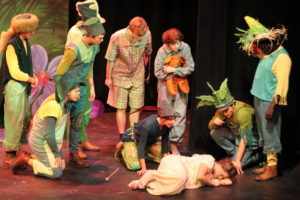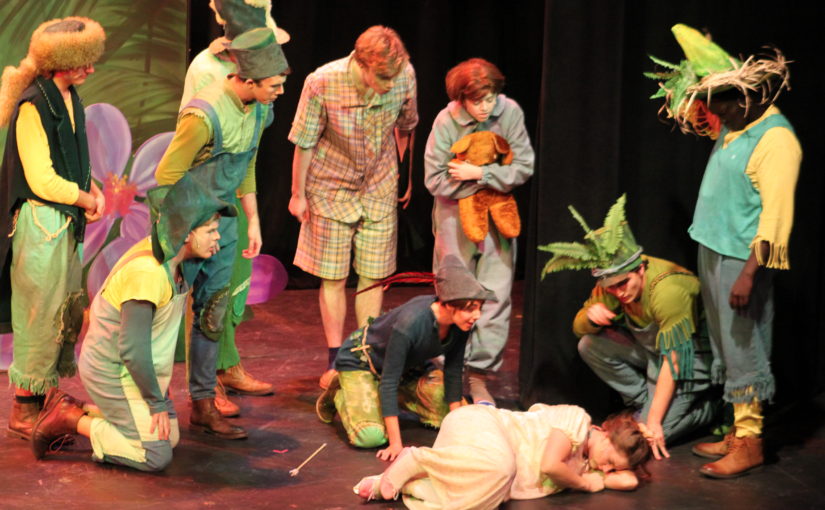
Act I: The Performance
As audience members, we see a very specific part of every production: the polished, well-rehearsed final product.
But that’s not how performances begin.
“Hold!” the stage manager yells, again. The actors on stage immediately drop their characters and squint past the stage lights toward the operating board. This is one of the first rehearsals combining both the technical and artistic aspects of Theatre NDSU’s first production of the year, “Peter Pan.”
Everyone is very aware opening night is only a week away.
“This is the biggest production of the year,” director Jessica Jung said. “Fun fact: there are more props in this production than there have been in the past 10 years. There’s flying, fight scenes with swords. The scope is bigger: there are more actors, more tech. Just more.”
“Peter Pan” is being staged in Festival Concert Hall, a much larger space than Askanase Auditorium, their usual stage. Every three years, Theatre NDSU hosts a large production in Festival.
Theatre NDSU has a rubric for what productions they need to perform every four years, covering a wide breadth of shows. This covers classics like Shakespeare as well as two musicals, one of which needs to be a Golden Age musical. Golden Age musicals debuted on Broadway between the years 1920 to 1959 and includes “Gypsy,” “Kiss Me, Kate,” “Hello, Dolly!” and “Peter Pan.”
While the bigness of “Peter Pan” seems daunting, rather than being overwhelmed, most cast members are invigorated.
“When I told my younger siblings, who love watching Disney’s ‘Jake and the Neverland Pirates,’ that we were doing ‘Peter Pan’ and I was Captain Hook, they started freaking out,” Alex Kleven said, a junior in theatre arts. “That was really cool, because with other plays like ‘Romeo and Juliet,’ they don’t really understand it and they don’t get as excited.”
Much like Kleven, Keanna Ellsely, a senior playing the role of Peter Pan, loved the accessibility of the play to younger audiences.
Ellsely is a huge supporter of Theatre for Young Audiences, a group dedicated to developing professional theater in younger generations and cultivating international exchange and cultural dialogue.
“Like they say, children are the future,” Ellsely said. “‘Peter Pan’ is really geared toward Theatre for Young Audiences and I’ve always dreamed of sharing it.”
“Peter Pan” isn’t just for kids, especially when you consider how integrated it is into pop culture: J. M. Barrie’s original novel is still on modern bookshelves, Disney’s “Peter Pan” is an animated classic and more interpretations of Peter’s adventures like “Hook,” “Finding Neverland,” “Peter Pan” (2003) and “Peter Pan Live!” still make it relevant.
“This may date me a little,” Jung chuckled, “but I wore out my VHS when I was little. I have a love for ‘Peter Pan,’ I’ve seen ‘Hook’ and ‘Finding Neverland.’ It really lives in my heart, so I knew we had to do it.”
Act II: The Cast
Backstage of rehearsal, there isn’t much indication a show is being performed right across the hall.
The cast of “Peter Pan” is bent over books and writing notes in the time between their scenes. All the characters are represented: Lost Boys combined with surly pirates, Tiger Lily’s the Pounce sitting next to Tic Toc Croc. For most of them, sitting backstage is just as common as sitting in a classroom. But for others, it’s out of the ordinary.
“Why did you audition for ‘Peter Pan,’ besides the requirement?” I asked. I quickly learned, while speaking to the cast theatre majors, they are required by the department to audition for every production.
“Oh, I’m not a theatre major,” freshman Matt St. Martin said. “I’m a computer science major.”
“There are a handful of non-majors in ‘Peter Pan,’” said Jung. “It’s been fun with more cast members. They add something special to the production, including new perspectives, which has been really fun.”
“I did theater in high school,” St. Martin added. “I fell in love with it. I didn’t want to miss out on it in college and wanted to try it. It’s definitely a new atmosphere from high school. I adore college theater, and I respect it a lot. There’s more professionalism yet we can still have fun.”
You really can’t tell where the theatre majors stop and the non majors begin. At the beginning of rehearsal, Jung calls the cast and crew into a “family meeting.” Everyone circles up on stage to address announcements and questions. But even after this initial joining together, you can still feel the “family” of the cast:
“Slightly is really the second in command,” senior Dan Ajak said of his character, a Lost Boy.
“According to Jess.” the other Lost Boys shout, resembling the bickering of children of who’s the favorite.
And, of course, everyone has their own take on each other’s character.
“Toodles is sentimental, sappy and childish,” said senior Cody Olson, a Lost Boy and the dance captain.
“Nibs is the baby but Toodles is the other baby,” Krissy Borud (Crocodile and Pounce member) cut in. “He’s the very sensitive one. He’s closest to Peter and is the saddest to leave. He’s also the cutest.”
While they may disagree, tease and harass one another, there’s no denying the connection between the cast members.
“I’ve really loved sharing this experience with my mates,” Ellsely said smiling.
Act III: The Technicalities
From the spotlight to the backstage, the sound, lights and other technical aspects of “Peter Pan” are the biggest part of the production.
After all, Peter won’t fly himself.
“It’s a really big production,” Jung stated. “There are fun costumes and big tech support. The Pounce have been working with dance instructor and professor of contemporary tap Patrick Kasper. He created rhythmical dances that are really advanced.”
So advanced, the Pounce members all had to be dancers and Tiger Lily has nearly 10 years of dance experience.
The costume designers have been working equally as hard on the costumes for the production. The Crocodile and Nana the dog are both played by actors, requiring intensive, detailed costumes.
“We could have had puppets,” Jung said. “But we were interested in actor animation and study of movement. The show is really about transformation. We watch Wendy grow up. Seeing an actor transition into a dog back into a human was really interesting and it fit into the story well. Why wouldn’t you want to see a human playing a dog?”
The Crocodile is complete with head-to-toe green scales, a tail and huge jaws. Nana is entirely made of rope, resembling the very real dog breed Komondor.
“The Crocodile has been really fun,” said Krissy Borud. “It provides a scary character that’s also really funny.”
Captain Hook agreed. “The Tic Toc Croc is really cool. I haven’t rehearsed with the full costume, but it’s been fun to develop a reaction to it. It’s an opportunity to be silly.”
And, who could forget the flying?
Since pixie dust is pretty hard to come by, actors are being rigged up to lines and wires to simulate flying to Neverland. Not only Peter, but Wendy, John and Michael Darling are also given the chance to fly, just like their characters do in the movies, adding a whole new level to Theatre NDSU.
“Peter Pan is the boy who can fly,” Olson said. “Who doesn’t want to fly when they’re a little kid?”
“Peter Pan” premiers at 7:30 p.m.,Oct. 20 in Festival Concert Hall. The show continues at 2:00 p.m. and 7:30 p.m. Oct. 21 and 2:00 p.m. Saturday, Oct. 22.
Tickets are free for NDSU students and can be purchased through the Division of Performing Arts Box Office at (701) 231-7969.
WHEN: 7:30 p.m. Oct. 20
2:00 p.m. & 7:30 p.m. Oct. 21
2:00 p.m. Oct. 22
WHERE: Festival Concert Hall
PRICE: Free for NDSU Students with I.D.
MORE INFO: Call (701) 231 – 7969
